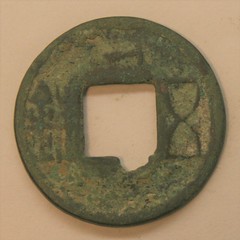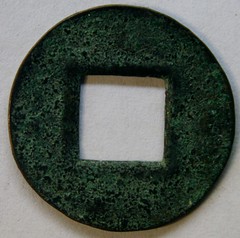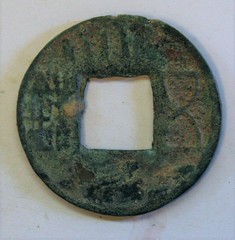
PREV ARTICLE
NEXT ARTICLE
FULL ISSUE
PREV FULL ISSUE
CHINESE WU ZHU COIN VARIETIES SYSTEM OFFEREDTed Puls writes:
"But, as my loving daughter tells, me- nobody else on the planet is interested. (I have to work on checking that the actual varieties in the spreadsheet list are correct. This may take me some time as the spreadsheet has well over 700 varieties). This could be made available someday, as well as pictures of all of them- already done." OK, let's prove that statement wrong. I'm sure there will be some interest in this great work. Ted can be reached at tedkate@comcast.net . Here's an excerpt from the manuscript. -Editor From the beginning of the Silk Road, the Chinese cast Wu Zhu coins as the primary money for most of the people on earth. The "militant" Emperor Wu of the Han Dynasty changed the previous long-lived coinage called the Pan Liang ("half ounce") into his coinage called the Wu Zhu ("five grains") in 118 B.C. This coinage was to be the preferred money until the founding of the Tang dynasty ca. 600 A.D. These coins circulate much longer. Some were recently found in a Liao Dynasty site dated 400 years later. The British found them circulating during the last imperial dynasty in the 19th century. They were copied for trade along the Silk Road using metals available to local mints. These were sometimes close to the originals and sometimes were made in distinctive types with a mix of the Chinese writing and the local Kotan writing on the same coin. The Official coinage was often very nicely cast but also degraded when the economy required debasement. During the later times called the Eastern Han the quality dropped significantly with the power of the emperor. After the fall of the dynasty a remarkable coinage of Wu Zhu were cast in amazingly small and light weight sizes by the temporarily successful general who defeated the Han. After this time of trial, a myriad of dynasties and kingdoms came and went often reviving the coinage somewhat. Wu Zhu were cast for at least 400 more years during these turbulent times. During the late Han Dynasty, the various mints began the curious practice of using varied marks in addition to the wu and zhu characters on the coinage. These marks were sometimes placed in the mold to result in a raised character and the marks were sometimes engraved into the surface after casting. The purpose of these marks is unknown at this writing. This unknown is one attraction of collecting these mysterious artifacts. I have not seen a satisfactory way of organizing these myriad marks to allow a start to classifying and of understanding them so this is my attempt. The number of marks or symbols is limited but the many ways they were used and combined in a vast quantity of types that calls for a system of organizing them.
This simple start is made more complicated by additional options in dot placement. The "dot above the hole" varieties seem to have dots placed near the inner hole, in the middle of the field, and also need the outer edge (low, medium and high placement). The dot on the hole was sometimes a half dot. If this wasn't enough the dot also could be placed not only centrally, but also to the right and the left of the middle of this "field". The total number of possible dot positions above the hole is nine. Below the hole the same numbers of possible spots can be seen. Spots for dots also were displayed in the fields above and below the wu and zhu characters. Zhu will have a similar set of options for dot placements. I haven't discerned the vertical low medium and high positioned dots in these fields. This suggests that three positions for dots exist in the fields above each character but also three more each for fields below these two characters. The wu containing field on the right of the hole has its own set of dot placements. Wu can have a dot in the middle of the character where the lines cross. Inside the hourglass like figure of wu, regular dots were placed in the upper space, the lower space, and sometimes a dot was placed in the upper and lower space. Triangular dots are found inside the hour glass also, which seem to be a distinctive design. Less commonly dots were places beside the waist of the Wu character toward the inner rim or on the outer rim side. Zhu dots are less clear. Some feel that raised area on the character are intentional dots rather than casting flaws. I haven't seen these dots repeated on two coins and believe they are casting errors.   Far more than dots are involved - there are half-dots, vertical and diagonal bars, raised and incuse carving, numerals, words and even subtle variations of mark size, shape and location. Again, Ted can be reached at tedkate@comcast.net for more infomration. -Editor  Wayne Homren, Editor The Numismatic Bibliomania Society is a non-profit organization promoting numismatic literature. See our web site at coinbooks.org. To submit items for publication in The E-Sylum, write to the Editor at this address: whomren@gmail.com To subscribe go to: https://my.binhost.com/lists/listinfo/esylum All Rights Reserved. NBS Home Page Contact the NBS webmaster 
|

